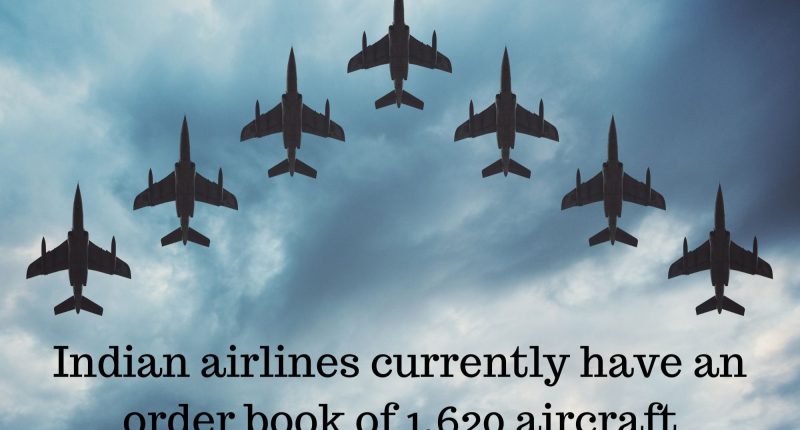
Opinions expressed by Entrepreneur contributors are their own.
You’re reading Entrepreneur India, an international franchise of Entrepreneur Media.
The surge of tourist traffic into India and the rising HNWIs has driven the growth of the general aviation sector in the country. However, despite having competitive edge, Indian aviation industry needs to navigate certain challenges in order to optimally make use of the opportunities.
The recent conclusion of the WINGS India 2024, witnessed different airlines achieve their set targets. Akasa Air announced a firm order of 150 fuel-efficient Boeing 737 MAX aircraft. The latest order, consisting of 737 MAX 10 and 737 MAX 8-200 jets will provide the airline a steady aircraft delivery stream through 2032, cementing the company’s domestic and international expansion plans.
Indian airlines currently have an order book of 1,620 aircraft, this is closer to rise to 2,000 aircraft by March 2025, said a latest report by CAPA India. This increase will be achieved as a result of Air India converting some of its 370 options to firm orders every few months, supplemented by possible further orders by other Indian carriers.
According to the Boeing Commercial Market Outlook 2023, South Asia is about to welcome over 2,700 new airplanes in the next two decades, with 90 percent destined for India. This growth projection also demands approximately 37,000 pilots and 38,000 mechanics in the region, largely led by India.
In 2023, Indian airlines ordered more aircraft than those from any other country. The total order book for Western aircraft is second only to the USA. “India is set to be the most exciting aviation market of the 21st century, with long-term rapid growth for both domestic and international traffic. However, in order to support this once-in-a-generation growth, there will need to be a complete re-think of India’s physical, institutional & skills infrastructure,” the CAPA report quoted.
Competitive edge
In addition to its massive home market, India has arguably the most favorable location among the five largest aviation markets in the world (the others being the US, China, UK and Japan), to act as a hub on the fastest growing intercontinental corridors.
The geographic location of the US as an end-of-the-line market means that it has limited opportunities to serve as an international hub. India may reach the size of China within 12-15 years. But China has an aviation industry that has a high degree of central government control and planning, which is not the case in India. Both China and Japan have locations that limit their hub potential to trans-Pacific routes. The UK has the ability to handle traffic to/from North America and Europe, which is certainly large in volume. But these will also be the slowest growing markets going forward. Australia, as has been shown, is the most similar to India in terms of market concentration. But by the end of this decade, India’s market will be almost five times the size of Australia, making parallels between them less relevant and Australia too is an end-of-the-line market, according to the CAPA India analysis.
India is therefore uniquely positioned, being the third largest, fastest growing and one of the most favorably located markets to be able to handle a massive home market and hub traffic. India will need to decide what kind of market it needs to be, and a robust institutional framework then needs to be developed with this in mind.
Current achievements
Marking a new dawn in the Indian aviation sector, Union Civil Aviation Minister Jyotiraditya Scindia unveiled India’s first Airbus A350 aircraft on the first day of Wings India 2024. “The A350 is a game-changer for Air India. It will not only elevate our passenger experience but also open up new routes and opportunities for expansion. Together with the full interior refit of our legacy widebody aircraft beginning mid-2024, this upgradation of fleet and product is a key pillar of returning Air India to the upper echelons of world aviation,” said Cambell Wilson, CEO and MD, Air India.
The sustainability of the A350 aircraft marks another milestone. Fitted with powerful and fuel-efficient Rolls-Royce Trent XWB engines, the Airbus boosts world’s most efficient large aero-engine, using the best technology and materials while benefiting from more than 70 million hours of in-service experience. In February 2023, Rolls-Royce announced an order from Air India for 68 Trent XWB-97 engines, plus options for 20 more, powering the Airbus A350-1000. The Tata-controlled airline also ordered 12 Trent XWB-84 engines, the sole engine option for the Airbus A350-900. “Our engines with Air India, will be 50 per cent SAF (sustainable aviation fuel) compatible from day one,” said Kishore Jayaraman, India president, Rolls-Royce.
On the sidelines of Wings India 2024, Rémi Maillard, President and MD, Airbus India and South Asia said Airbus will double its sourcing from India to USD 1.5 billion by the end of the decade from the existing USD 750 million. Notably, India will need 2,840 new aircraft and 41,000 pilots as well as 47,000 technical staff in the next 20 years.
Reflecting a similar opinion, Salil Gupte, heading the Indian arm of Boeing, had earlier told Entrepreneur India, “India’s commercial aviation market is expected to become the third-largest in the world by 2041, with a fleet size nearly quadrupling compared to 2019. The country is projected to receive over 90 per cent of South Asia’s airplane deliveries, requiring over 2,400 new aircraft, while its cargo market is set to expand significantly, with the fleet growing from 15 to 80 airplanes by 2042, driving a $135 billion demand for commercial services,” highlighting the substantial demand in South Asia for 37,000 pilots and 38,000 maintenance technicians over the next two decades.
Navigating challenges
High taxes on Aviation Turbine Fuel (ATF) in India present a multifaceted challenge to the domestic airline industry. ATF accounts for a substantial portion of airline operating costs, sometimes reaching as high as 40-45 percent. These high taxes strain airlines’ financial viability, potentially leading to reduced margins, exit from few routes and fare hikes, hindering the sector’s growth. Taking action towards the same, the government has reduced prices: ATF price was cut by INR 4,162.5, or 3.9 per cent, in the national capital to INR 101,993.17 per kl, according to price notifications of state-owned fuel retailers. This is the third straight monthly reduction in jet fuel prices. After the reduction, IndiGo said it has stopped collecting fuel charges on tickets, nearly three months after introducing the levy in the wake of a surge in jet fuel prices.
With a robust fleet size in order, maintenance, repair, and overhaul (MRO) capabilities are now imperative. Ensuring aircraft safety and reliability demands significant investments in MRO infrastructure and expertise. This effort not only enhances safety but also fosters job creation and technological advancement in the aviation sector. According to a CII analysis, the primary challenge lies in component and engine MRO, where most spending occurs. However, new aircraft models driving local repair stations are a decade away. Efforts to bolster India’s MRO capabilities, especially in components and engines, are essential to support the growing aviation sector, create jobs, and enhance technological prowess.
In the short-term, the industry will need to handle a couple of critical challenges for the next 1-2 years. In addition to serious ongoing supply chain issues, airlines now have to deal with the impact of the revised Flight Duty Time Limitations. “The recent revisions to the Flight Duty Time Limitations may result in airlines having to increase their pilot numbers by closer to 20 per cent in order to be able to remain compliant with operating the current schedule, let alone future growth. And this is happening at a time when there is a structural global shortage of pilots. Indian carriers will be competing with expanding airlines in the Gulf and Asia in particular, for a constrained pool of pilots,” the CAPA analysis quoted.
Supply chain issues will remain a concern for the foreseeable future as there are currently 160 aircraft on the ground, which could increase to around 200 by the end of Mar-2024, representing almost 25 per cent of the aircraft on the register. There is continuing uncertainty since nobody can determine the timeframe by which these issues will be resolved, nor rule out the possibility of further issues emerging. These hurdles need to be addressed in order to fly further.
The India Aviation Market size is estimated at USD 13.54 billion in 2024, and is expected to reach USD 23.24 billion by 2029, growing at a CAGR of 11.41 per cent during the forecast period (2024-2029), said Mordar Intelligence in its latest analysis.
This article is from Entrepreneur.com









